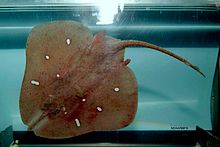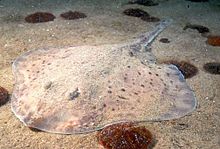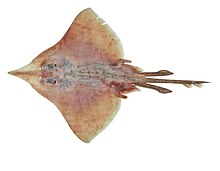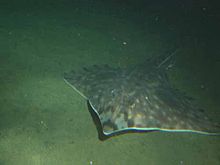Real rays
| Real rays | ||||||||||||
|---|---|---|---|---|---|---|---|---|---|---|---|---|

|
||||||||||||
| Systematics | ||||||||||||
|
||||||||||||
| Scientific name | ||||||||||||
| Rajidae | ||||||||||||
| Blainville , 1816 |
The real rays (Rajidae) are the largest family of rays with 15 genera and almost 180 species .
distribution
Real rays live in all oceans from the Arctic to the Antarctic . Most species live in the temperate seas on mud, sand or gravel bottoms. They are rare in the tropics . They are absent in Polynesia , Hawaii , Micronesia , the Caribbean coast of South America and in coral reefs .
features
The real rays have a rhombic (diamond-shaped), strongly flattened body. The slender, thornless tail is clearly set off. They have weak electrical organs on either side of the tail. The tail is slender, has two side folds and has two reduced dorsal and one small caudal fin. There are species with a pointed and blunt rostrum. The skin is rough covered with small thorns and bumps. The females are usually significantly larger than the males. Shallow water species are light, almost white on the underside. Species from the deep sea are dark on both sides. There are five pairs of gills on the underside. The mouth is straight to curved and has numerous teeth. Real rays eat soil-dwelling organisms. The locomotion takes place through wave-like movements (undulation) of their greatly enlarged pectoral fins.
The best known is the Rajide nail skate ( Raja clavata ), which occurred on European shores of the Black Sea to the Barents lives. The spotted ray ( Raja montagui ) is also common. The common skate ( Dipturus batis ) is now on the IUCN Red List as " Critically Endangered " .
Reproduction
In contrast to all other rays that are ovoviviparous (egg-giving birth to life), the real rays lay eggs, which are popularly known as "mermaid bags" or "mermaid bags". The horny egg capsule is rectangular with a thread at each corner. There are slots in the capsule through which the sea water can flow in and supply the embryo with oxygen. You can tell the species from the shape of the eggs . The young rays hatch after 4 to 14 months.
Internal system
- Amblyrajini tribe
- Genus Amblyraja Malm, 1877
- Amblyraja badia (Garman, 1899)
- Amblyraja doellojuradoi (Pozzi, 1935)
- Amblyraja frerichsi (Krefft, 1968)
- Amblyraja georgiana (Norman, 1938)
- Arctic ray ( Amblyraja hyperborea (Collett, 1879))
- Jensen's rays ( Amblyraja jenseni (Bigelow & Schroeder, 1950))
- Star ray ( Amblyraja radiata (Donovan, 1808))
- Amblyraja reversa (Lloyd, 1906)
- Amblyraja robertsi (Hulley, 1970)
- Amblyraja taaf (Meisner, 1987)
- Genus Breviraja Bigelow & Schroeder , 1948
- Breviraja claramaculata McEachran & Matheson, 1985
- Breviraja colesi Bigelow & Schroeder, 1948
- Breviraja marklei McEachran & Miyake, 1987
- Breviraja moldi McEachran & Matheson, 1995
- Breviraja nigriventralis McEachran & Matheson, 1985
- Breviraja spinosa Bigelow & Schroeder, 1950
- Genus Dactylobatus Bean & Weed, 1909
- Dactylobatus armatus Bean & Weed, 1909
- Dactylobatus clarkii (Bigelow & Schroeder, 1958)
- Genus Leucoraja Malm, 1877
- Leucoraja caribbaea (McEachran, 1977)
- Sandray ( Leucoraja circularis (Couch, 1838))
- Leucoraja compagnoi (Stehmann, 1995)
- Little ray ( Leucoraja erinacea (Mitchill, 1825))
- Chagrin ray ( Leucoraja fullonica (Linnaeus, 1758))
- Rosette ray ( Leucoraja garmani (Whitley, 1939))
- Leucoraja lentiginosa (Bigelow & Schroeder, 1951)
- Leucoraja leucosticta (Stehmann, 1971)
- Maltese ray ( Leucoraja melitensis (Clarck, 1926))
- Cuckoo ray ( Leucoraja naevus (Müller & Henle, 1841))
- Winter rays ( Leucoraja ocellata (Mitchill, 1815))
- Leucoraja pristispina Last, Stehmann & Séret, 2008
- Leucoraja virginica (McEachran, 1977)
- Leucoraja wallacei (Hulley, 1970)
- Leucoraja yucatanensis (Bigelow & Schroeder, 1950)
- Genus Rajella Stehmann, 1970
- Rajella annandalei (Weber, 1913)
- Rajella barnardi (Norman, 1935)
- Deep water rays ( Rajella bathyphila (Holt & Byrne, 1908))
- Bigelows Rochen ( Rajella bigelowi (Stehmann, 1978))
- Rajella caudaspinosa (From Bonde & Swart, 1923)
- Rajella challengeri Last & Stehmann, 2008
- Deepwater ghost rays ( Rajella dissimilis (Hulley, 1970))
- Rajella Eisenhardti Long & McCosker, 1999
- Rajella fuliginea (Bigelow & Schroeder, 1954)
- Fyllarochen ( Rajella fyllae (Lütken, 1887))
- Kukujev's rays ( Rajella kukujevi (Dolganov, 1985))
- Rajella leopardus (From Bonde & Swart, 1923)
- White rays ( Rajella lintea (Fries, 1838))
- Rajella nigerrima (de Buen, 1960)
- Rajella paucispinosa Weigmann et al., 2014
- Rajella purpuriventralis (Bigelow & Schroeder, 1962)
- Rajella ravidula (Hulley, 1970)
- Rajella sadowskii (Krefft & Stehmann, 1974)
- Genus Amblyraja Malm, 1877
- Tribus Rajini
- Genus Dentiraja Whitley, 1940
- Dentiraja australis (Macleay, 1884)
- Dentiraja cerva (Whitley, 1939)
- Dentiraja confusa (Last, 2008)
- Dentiraja endeavouri (Last, 2008)
- Dentiraja falloargus (Last, 2008)
- Dentiraja flindersi (Last & Gledhill, 2008)
- Dentiraja healdi (Last, White & Pogonoski, 2008)
- Dentiraja lemprieri (Richardson, 1845)
- Dentiraja oculus (Last, 2008)
- Dentiraja polyommata (Ogilby, 1910)
- Genus Dipturus Rafinesque, 1810
- Dipturus acrobelus Last, White & Pogonoski, 2008
- Dipturus apricus Last, White & Pogonoski, 2008
- Dipturus argentinensis Díaz de Astarloa, Mabragaña, Hanner & Figueroa, 2008
- Common skate ( Dipturus batis (Linnaeus, 1758))
- Dipturus bullisi (Bigelow & Schroeder, 1962)
- Dipturus campbelli (Wallace, 1967)
- Dipturus canutus Last, 2008
- Dipturus chilensis (Guichenot, 1848)
- Dipturus crosnieri (Séret, 1989)
- Dipturus diehli Soto & Mincarone, 2001
- Dipturus doutrei (Cadenat, 1960)
- Dipturus ecuadoriensis (Beebe & Tee-Van, 1941)
- Dipturus flavirostris (Philippi, 1892)
- Dipturus garricki (Bigelow & Schroeder, 1958)
- Dipturus gigas (Ishiyama, 1958)
- Dipturus grahami Last, 2008
- Dipturus gudgeri (Whitley, 1940)
- Dipturus innominatus (Garrick & Paul, 1974)
- Dipturus intermedius (Parnell, 1837)
- Dipturus johannisdavisi (Alcock, 1899)
- Dipturus kwangtungensis (Chu, 1960)
- Barn skate ( Dipturus laevis (Mitchill, 1818))
- Dipturus lamillai Concha et al., 2019
- Dipturus lanceorostratus (Wallace, 1967)
- Dipturus leptocauda (Krefft & Stehmann, 1975)
- Dipturus macrocauda (Ishiyama, 1955)
- Dipturus maugeana (Last & Gledhill, 2007)
- Dipturus melanospilus Last, White & Pogonoski, 2008
- Dipturus mennii Gomes & Paragó, 2001
- Dipturus nasuta (Müller & Henle, 1841)
- Black-bellied skate ( Dipturus nidarosiensis (Storm, 1881))
- Dipturus olseni (Bigelow & Schroeder, 1951)
- Dipturus oregoni (Bigelow & Schroeder, 1958)
- Pointed Ray ( Dipturus oxyrinchus (Linnaeus, 1758))
- Dipturus pullopunctatus (Smith, 1964)
- Dipturus queenslandicus Last, White & Pogonoski, 2008
- Dipturus springeri (Wallace, 1967)
- Dipturus stenorhynchus (Wallace, 1967)
- Dipturus teevani (Bigelow & Schroeder, 1951)
- Dipturus tengu (Jordan & Fowler, 1903)
- Dipturus trachyderma (Krefft & Stehmann, 1975)
- Dipturus wengi Séret & Last, 2008
- Dipturus wuhanlingi Jeong & Nakabo, 2008
- Genus Hongeo Jeong & Nakabo, 2009
- Hongeo koreana (Jeong & Nakabo, 1997)
- Genus Spiniraja Whitley, 1939
- Spiniraja whitleyi (Iredale, 1938)
- Genus Okamejei Ishiyama, 1958
- Okamejei acutispina (Ishiyama, 1958)
- Okamejei arafurensis Last & Gledhill, 2008
- Okamejei boesemani (Ishihara, 1987)
- Okamejei cairae Last, Fahmi & Ishihara, 2010
- Okamejei heemstrai (McEachran & Fechhelm, 1982)
- Okamejei hollandi (Jordan & Richardson, 1909)
- Okamejei kenojei (Müller & Henle, 1841)
- Okamejei leptoura Last & Gledhill, 2008
- Okamejei meerdervoortii (Bleeker, 1860)
- Okamejei mengae Jeong, Nakabo & Wu, 2007
- Okamejei ornata Weigmann et al., 2015
- Okamejei pita (Fricke & Al-Hassan, 1995)
- Okamejei schmidti (Ishiyama, 1958)
- Genus Raja Linnaeus, 1758
- Raja ackleyi Garman, 1881
- African ray ( Raja africana Capapé, 1977)
- Mediterranean star rays ( Raja asterias Delaroche, 1809)
- Raja bahamensis Bigelow & Schroeder, 1965
- Raja binoculata Girard, 1855
- Blond ray ( Raja brachyura Lafont, 1873)
- Raja cervigoni Bigelow & Schroeder, 1964
- Raja chinensis Basilewsky, 1855
- Thorny rays ( Raja clavata Linnaeus, 1758)
- Raja cortezensis McEachran & Miyake, 1988
- Raja eglanteria Bosc, 1800
- Raja equatorialis Jordan & Bollman, 1890
- Raja Herwigi Krefft, 1965
- Raja inornata Jordan & Gilbert, 1881
- Madeira rays ( Raja maderensis Lowe, 1838)
- Small- eyed ray ( Raja microocellata Montagu, 1818)
- Mirror ray ( Raja miraletus Linnaeus, 1758)
- Spotted ray ( Raja montagui Fowler, 1910)
- Raja parva Last & Séret, 2016
- Poly spotted ray ( Raja polystigma Regan, 1923)
- Raja pulchra Liu, 1932
- Skate ray ( Raja radula Delaroche, 1809)
- Raja rhina Jordan & Gilbert, 1880
- Rondelet's rays ( Raja rondeleti Bougris, 1959)
- Raja rouxi Capapé, 1977
- Raja stellulata Jordan & Gilbert, 1880
- Raja straeleni Poll, 1951
- Raja texana Chandler, 1921
- Marble rays ( Raja undulata Lacépéde, 1802)
- Raja velezi Chirichigno F., 1973
- Genus Dentiraja Whitley, 1940
- Tribus Rostrorajini
- Genus Malacoraja Stehmann, 1970
- Krefft's ray ( Malacoraja kreffti (Stehmann, 1977))
- Malacoraja obscura Carvalho, Gomes & Gadig, 2005
- Malacoraja senta (Garman, 1885)
- Samkin Rays ( Malacoraja spinacidermis (Barnard, 1923))
- Genus Neoraja McEachran & Campagno, 1982
- Neoraja africana (Stehmann & Séret, 1983)
- Blue dwarf large ( Neoraja caerulea (Stehmann, 1976))
- Neoraja carolinensis McEachran & Stehmann, 1984
- Neoraja iberica Stehmann, Séret, Costa & Baro, 2008
- Neoraja stehmanni (Hulley, 1972)
- Genus Orbiraja Last, Weigman & Dumale, 2016
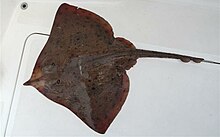 Sea skate ( Rostroraja alba )
Sea skate ( Rostroraja alba )- Orbiraja jensenae (Last & Lim, 2010)
- Orbiraja philipi (Lloyd, 1906)
- Orbiraja powelli (Alcock, 1898)
- Genus Rostroraja Hulley, 1972
- Sea skate ( Rostroraja alba (Lacépéde, 1803))
- Genus Malacoraja Stehmann, 1970
The "soft-nosed rays" originally assigned to the real rays as the subfamily Arhynchobatinae are now mostly considered an independent family (→ Arhynchobatidae ), the genera Cruriraja , Fenestraja and Gurgesiella were assigned to the Gurgesiellidae family .
swell
literature
- Joseph S. Nelson : Fishes of the world , Fourth Edition, Wiley & Sons, Hoboken 2006, ISBN 978-0-471-25031-9
Individual evidence
- ↑ a b Last, PR, Weigmann, S. & Yang, L. (2016): Changes to the nomenclature of the skates (Chondrichthyes: Rajiformes). Pages 11 to 34 in Last, PR & Yearsley, GK (Ed.) (2016): Rays of the World : Supplementary information. CSIRO Australian National Fish Collection.
- ↑ Kelcie L. Chiquillo, David A. Ebert, Christina J. Slager and Karen D. Crow: The secret of the mermaid's purse: Phylogenetic affinities within the Rajidae and the evolution of a novel reproductive strategy in skates. Mol Phylogenet Evol. 2014 Jun; 75: 245-251. doi: 10.1016 / j.ympev.2014.01.012
- ↑ Family Arhynchobatidae on Fishbase.org (English)
Web links
- Real rays on Fishbase.org (English)
- Myers, P., Espinosa R., Parr CS, Jones T., Hammond GS & TA Dewey. 2008. The Animal Diversity Web (online). Family Rajidae (rays and skates)



